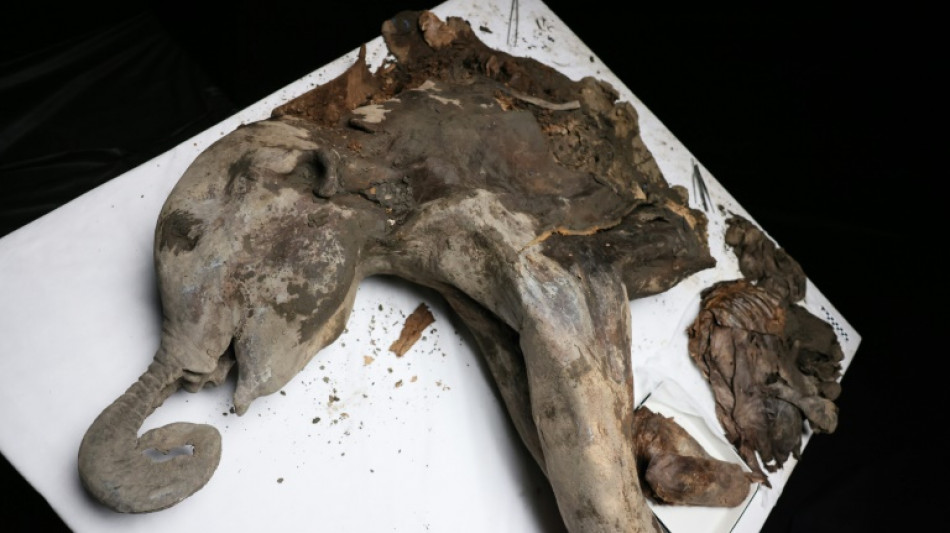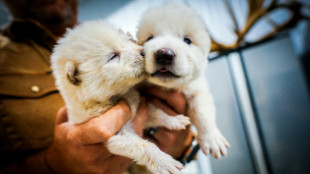
-
 Cash-strapped Nigerians turn to YouTube for entertainment
Cash-strapped Nigerians turn to YouTube for entertainment
-
Two dead as fans, police clash before Copa Libertadores game in Chile

-
 Flowers in their hair: Shan boys ordained into Buddhist monkhood
Flowers in their hair: Shan boys ordained into Buddhist monkhood
-
Edwards leads Wolves past Grizzlies as playoff race heats up

-
 Ancelotti questioned as Real Madrid face Alaves
Ancelotti questioned as Real Madrid face Alaves
-
Old foes Bayern and Dortmund face off amid spectre of European exit

-
 Early holiday, more fans: Philippines schools adapt to climate change
Early holiday, more fans: Philippines schools adapt to climate change
-
In skies, as on land, European forces face gaps if US pulls back

-
 Digital divas: Can Japan's virtual YouTuber craze crack America?
Digital divas: Can Japan's virtual YouTuber craze crack America?
-
WHO pandemic agreement talks face deadline crunch

-
 Stocks, dollar sink and gold hits record as Trump tariff panic returns
Stocks, dollar sink and gold hits record as Trump tariff panic returns
-
LeMond hails 'one in a million' Pogacar ahead of Paris-Roubaix debut

-
 Liverpool can move closer to the title as top five tension mounts
Liverpool can move closer to the title as top five tension mounts
-
Trump admits trade war 'cost' as markets hit

-
 AI only just beginning to revolutionize the NBA game
AI only just beginning to revolutionize the NBA game
-
Despite Trump pause, overall US tariff rate at highest in a century

-
 'A pain that doesn't subside' at funerals for Dominican nightclub disaster victims
'A pain that doesn't subside' at funerals for Dominican nightclub disaster victims
-
Panama deal allows US to deploy troops to canal

-
 US firm says it brought back extinct dire wolves
US firm says it brought back extinct dire wolves
-
Grieving Dominicans start burying 220 victims of nightclub disaster

-
 Aberg closes strong at 'sneaky hard' Augusta National
Aberg closes strong at 'sneaky hard' Augusta National
-
US auto union praises some Trump tariffs

-
 Australian IVF clinic admits embryo mix-up
Australian IVF clinic admits embryo mix-up
-
Rose: I've played well enough to win Masters but lack the jacket

-
 Rose again enjoys 'luxury' of first-round Masters lead
Rose again enjoys 'luxury' of first-round Masters lead
-
Rose rockets to Masters lead, defending champ Scheffler in pursuit

-
 Tesla opens first showroom in oil-rich Saudi
Tesla opens first showroom in oil-rich Saudi
-
Oscars to add new award for stunts

-
 Hatton loves being at Masters but 'It's just so hard'
Hatton loves being at Masters but 'It's just so hard'
-
'Mistakes can happen': Amorim backs Onana after Lyon nightmare

-
 RFK Jr says study will reveal cause of autism 'epidemic'
RFK Jr says study will reveal cause of autism 'epidemic'
-
Tourist family, pilot killed in 'tragic' NY helicopter crash

-
 No.1 Scheffler makes strong Masters start to defend title
No.1 Scheffler makes strong Masters start to defend title
-
Man Utd and Spurs draw in Europa League, Rangers hold Athletic

-
 Rose rockets to Masters lead with Scheffler and McIlroy in pursuit
Rose rockets to Masters lead with Scheffler and McIlroy in pursuit
-
Man Utd held late in Lyon after Onana errors in Europa League

-
 Man Utd held late in Lyon after Onana errors
Man Utd held late in Lyon after Onana errors
-
Wall Street rally fizzles as tariff fears resurface

-
 MLS to open 'second phase' of major season overhaul study
MLS to open 'second phase' of major season overhaul study
-
Argentina braves 24-hour strike as it awaits word on IMF loan

-
 Spain's Ballester finds relief in Masters water hazard
Spain's Ballester finds relief in Masters water hazard
-
Porro rescues Postecoglou as Spurs held by Frankfurt

-
 Grieving Dominicans start burying 200+ victims of nightclub disaster
Grieving Dominicans start burying 200+ victims of nightclub disaster
-
CONMEBOL proposes one-off 64-team World Cup in 2030

-
 Rybakina on form for Kazakhstan in BJK Cup
Rybakina on form for Kazakhstan in BJK Cup
-
Former Real Madrid coach Leo Beenhakker dies aged 82

-
 Rose rockets to top of Masters leaderboard, Scheffler one back
Rose rockets to top of Masters leaderboard, Scheffler one back
-
Langer fades after fiery start in Masters farewell

-
 Iran, US raise stakes ahead of key talks in Oman
Iran, US raise stakes ahead of key talks in Oman
-
US-China confrontation overshadows Trump's 'beautiful' trade war


Yana, a 130,000-year-old baby mammoth, goes under the scalpel
Making incisions and carefully taking samples, the scientists at a laboratory in Russia's far east looked like pathologists carrying out a post-mortem.
But the body they were dissecting is a baby mammoth who died around 130,000 years ago.
Discovered last year, the calf -- nicknamed Yana, for the river basin where she was found -- is in a remarkable state of preservation, giving scientists a glimpse into the past and, potentially, the future as climate change thaws the permafrost in which she was found.
Yana's skin has kept its greyish-brown colour and clumps of reddish hairs. Her wrinkled trunk is curved and points to her mouth. The orbits of her eyes are perfectly recognisable and her sturdy legs resemble those of a modern-day elephant.
This necropsy -- an autopsy on an animal -- "is an opportunity to look into the past of our planet", said Artemy Goncharov, head of the Laboratory of Functional Genomics and Proteomics of Microorganisms at the Institute of Experimental Medicine in Saint Petersburg.
Scientists hope to find unique ancient bacteria and carry out genetic analysis of the plants and spores Yana ate to learn more about the place and time she lived.
The calf largely avoided the ravages of time because she lay for thousands of years encased in permafrost in the Sakha region in Siberia.
Measuring 1.2 metres (nearly four feet) at the shoulder and two metres long, and weighing 180 kilogrammes (nearly 400 pounds), Yana could be the best-preserved mammoth specimen ever found, retaining internal organs and soft tissues, the Russian scientists said.
- Stomach, intestines -
Dissecting her body is a treasure trove for the half-dozen scientists that were carrying out the necropsy in late March at the Mammoth Museum at North-Eastern Federal University in the regional capital, Yakutsk.
Wearing white sterile bodysuits, goggles and facemasks, the zoologists and biologists spent several hours working on the front quarters of the mammoth, a species that died out almost 4,000 years ago.
"We can see that many organs and tissues are very well preserved," Goncharov said.
"The digestive tract is partly preserved, the stomach is preserved. There are still fragments of the intestines, in particular the colon," enabling scientists to take samples, he said.
They are "searching for ancient microorganisms" preserved inside the mammoth, so they can study their "evolutionary relationship with modern microorganisms," he said.
While one scientist cut Yana's skin with scissors, another made an incision in the inner wall with a scalpel. They then placed tissue samples in test tubes and bags for analysis.
Another table held the mammoth's hindquarters, which remained embedded in a cliff when the front quarters fell below.
The scent emanating from the mammoth was reminiscent of a mixture of fermented earth and flesh, macerated in the Siberian subsoil.
"We are trying to reach the genitals," said Artyom Nedoluzhko, director of the Paleogenomics Laboratory of the European University at Saint Petersburg.
"Using special tools, we want to go into her vagina in order to gather material to understand what microbiota lived in her when she was alive."
- 'Milk tusks' -
Yana was first estimated to have died around 50,000 years ago, but is now dated at "more than 130,000 years" following analysis of the permafrost layer where she lay, said Maxim Cheprasov, director of the Mammoth Museum.
As for her age at death, "it's already clear that she is over a year old because her milk tusks have already appeared," he added.
Both elephants and mammoths have early milk tusks that later fall out.
Scientists are yet to determine why Yana died so young.
At the time when this herbivore mammal was chewing grass, "here on the territory of Yakutia there were not yet any humans", Cheprasov said, since they appeared in modern-day Siberia between 28,000 and 32,000 years ago.
The secret to Yana's exceptional preservation lies in the permafrost: the soil in this region of Siberia that is frozen year-round and acts like a gigantic freezer, preserving the carcasses of prehistoric animals.
The discovery of Yana's exposed body came about because of thawing permafrost, which scientists believe is due to global warming.
The study of the microbiology of such ancient remains also explores the "biological risks" of global warming, Goncharov said.
Some scientists are researching whether the melting permafrost could release potentially harmful pathogens, he explained.
"There are some hypotheses or conjectures that in the permafrost there could be preserved pathogenic microorganisms, which when it thaws can get into the water, plants and the bodies of animals -- and humans," he said.
D.Bachmann--VB



